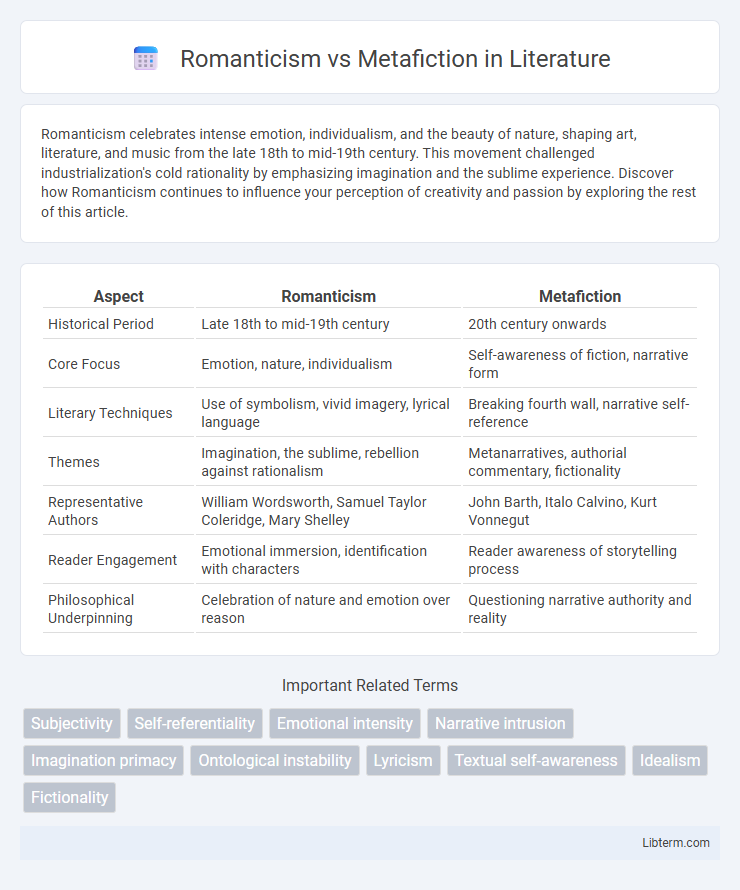Romanticism celebrates intense emotion, individualism, and the beauty of nature, shaping art, literature, and music from the late 18th to mid-19th century. This movement challenged industrialization's cold rationality by emphasizing imagination and the sublime experience. Discover how Romanticism continues to influence your perception of creativity and passion by exploring the rest of this article.
Table of Comparison
| Aspect | Romanticism | Metafiction |
|---|---|---|
| Historical Period | Late 18th to mid-19th century | 20th century onwards |
| Core Focus | Emotion, nature, individualism | Self-awareness of fiction, narrative form |
| Literary Techniques | Use of symbolism, vivid imagery, lyrical language | Breaking fourth wall, narrative self-reference |
| Themes | Imagination, the sublime, rebellion against rationalism | Metanarratives, authorial commentary, fictionality |
| Representative Authors | William Wordsworth, Samuel Taylor Coleridge, Mary Shelley | John Barth, Italo Calvino, Kurt Vonnegut |
| Reader Engagement | Emotional immersion, identification with characters | Reader awareness of storytelling process |
| Philosophical Underpinning | Celebration of nature and emotion over reason | Questioning narrative authority and reality |
Understanding Romanticism: Core Ideals and Influence
Romanticism emphasizes emotion, individualism, and the sublime beauty of nature, shaping 19th-century literature with its focus on imagination and personal experience. Central themes include the celebration of creativity, the glorification of the past, and a deep connection to the natural world, influencing poets like William Wordsworth and novelists such as Mary Shelley. This movement lays the foundation for exploring subjective truth, which is later deconstructed in metafiction through self-referential and non-linear narrative techniques.
Defining Metafiction: Breaking the Narrative Fourth Wall
Metafiction is a literary device that self-consciously breaks the narrative fourth wall by drawing attention to its own artificiality and construction. Unlike Romanticism, which emphasizes emotional depth, individual experience, and the sublime, metafiction deliberately disrupts traditional storytelling to explore the relationship between fiction and reality. This technique challenges readers to question the nature of narrative and the boundaries between author, text, and audience.
Historical Origins: Romanticism and Metafiction in Context
Romanticism emerged in the late 18th century as a reaction against the Enlightenment's emphasis on reason, prioritizing emotion, individualism, and nature, rooted in the historical turmoil of the French and American Revolutions. Metafiction, gaining prominence in the mid-20th century, reflects postmodern skepticism toward traditional narrative structures, emphasizing self-awareness and the constructed nature of storytelling amid the cultural shifts of postwar modernity. Both movements respond to their respective socio-historical contexts by challenging prevailing literary conventions and exploring new forms of expression.
Key Themes: Emotion vs. Self-Referentiality
Romanticism emphasizes intense emotion, individual experience, and the sublime in nature, highlighting themes of passion, freedom, and the human spirit's connection to the natural world. Metafiction explores self-referentiality by drawing attention to its own fictionality, questioning narrative structures and the relationship between author, text, and reader. The stark contrast lies in Romanticism's focus on authentic emotional expression versus Metafiction's playfulness with form and awareness of storytelling as an artifice.
Narrative Techniques: Lyrical Prose vs. Narrative Playfulness
Romanticism employs lyrical prose characterized by rich, emotive language and vivid imagery that evoke deep emotional resonance and individual experience. Metafiction utilizes narrative playfulness, breaking the fourth wall and self-referential techniques to challenge traditional storytelling conventions and engage readers in a conscious reflection on the act of narration. These contrasting narrative techniques highlight Romanticism's focus on immersive emotional expression versus Metafiction's emphasis on intellectual experimentation and narrative self-awareness.
The Role of the Author: Inspired Genius vs. Self-Conscious Creator
Romanticism emphasizes the author as an inspired genius whose creative process is driven by emotion and individual intuition, highlighting originality and divine inspiration. In contrast, Metafiction presents the author as a self-conscious creator who deliberately constructs narratives, often drawing attention to the artificiality of storytelling and questioning traditional notions of authorship. This shift redefines the role of the author from a mysterious originator of profound truths to a reflective artist engaged in a dialogue with the text and its audience.
Notable Works: Iconic Romantic and Metafictional Texts
Notable Romantic works include Mary Shelley's *Frankenstein*, William Wordsworth's *Lyrical Ballads*, and John Keats's *Ode to a Nightingale*, each emphasizing emotion, nature, and individual experience. Metafictional texts such as Italo Calvino's *If on a winter's night a traveler*, Jorge Luis Borges's *Labyrinths*, and Kurt Vonnegut's *Slaughterhouse-Five* challenge narrative conventions by self-referentially exploring the nature of storytelling. These iconic works reflect the thematic and structural contrasts between Romanticism's focus on imaginative depth and Metafiction's interrogation of literary creation.
Reader Engagement: Immersion vs. Critical Distance
Romanticism emphasizes immersive reader engagement by evoking intense emotions and vivid imagery that draw readers deeply into the narrative world. Metafiction encourages critical distance by highlighting the constructed nature of the text, prompting readers to analyze and question the storytelling process itself. This contrast shifts the reader's role from passive immersion in Romanticism to active reflection and awareness in Metafiction.
Lasting Impact: Romanticism and Metafiction in Modern Literature
Romanticism's lasting impact in modern literature is evident through its emphasis on individual emotion, nature, and the sublime, which continue to inspire contemporary writers exploring human experience and creativity. Metafiction reshapes narrative structures by self-consciously addressing the act of storytelling, influencing postmodern and experimental literature to challenge traditional boundaries between fiction and reality. Both movements contribute significantly to modern literary theory and practice, fostering deeper analytical engagement and innovation in narrative form.
Romanticism vs. Metafiction: A Comparative Analysis
Romanticism emphasizes emotion, individualism, and nature, often portraying heroic characters and idealized settings to evoke deep feelings. Metafiction, by contrast, self-consciously addresses the nature of fiction itself, employing narrative techniques that break the fourth wall and challenge traditional storytelling conventions. This comparative analysis highlights Romanticism's immersive, sentiment-driven narratives against Metafiction's critical, self-reflexive approach to literature and reality.
Romanticism Infographic

 libterm.com
libterm.com